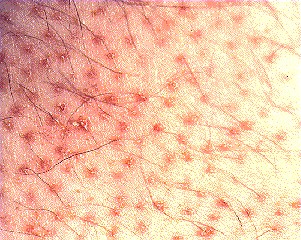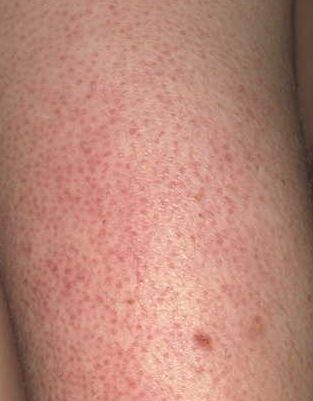Keratosis Pilaris and Dry Skin
 Keratosis Pilaris is not something most people know about despite an estimated 40 percent of the population experiencing.
Keratosis Pilaris is not something most people know about despite an estimated 40 percent of the population experiencing.
And since this issue is due to keratin a protein found in hair, and we have gotten several user email’s asking for more information we present the following information.
Dry skin and keratosis pilaris are common. Dry skin can occur at any age and for many reasons. Keratosis pilaris is an inherited skin condition that develops in up to 40 percent of the population. Sometimes a dermatologist’s help is necessary to get relief from dry skin and keratosis pilaris.
Dry Skin
Skin becomes dry when it loses too much water or oil. This is why skin generally becomes drier as we age, during the winter, and in low-humidity climates such as Arizona. Restoring lost moisture can make the skin softer, smoother, and less likely to crack. Below are some tips that can diminish dry skin.
 Dry Skin Care Tips
Dry Skin Care Tips
- SHAVING – It is best to shave after bathing when hairs are soft. To minimize the irritating effects of shaving (face or legs) on dry skin, make sure you use a shaving cream or gel. Allow the product to remain on the skin approximately 3 minutes before starting, and shave in the direction that the hair grows. Changing blades often, most certainly after 5 to 7 shaves, also will help minimize the irritating effects of shaving.
- AVOID HOT WATER – Hot water removes your natural skin oils more quickly; warm water is best for bathing.
- USE A MILD SOAP – Deodorant bars, strong fragrances in soaps, and products containing alcohol can strip natural oils from the skin. This dries the skin. Look for a mild, fragrance-free soap or cleanser that moisturizes..
- MOISTURIZE IMMEDIATELY AFTER BATHS AND SHOWERS – A 5- to 10-minute bath or shower adds moisture to the skin. Spending more time in the water often leaves your skin less hydrated than before you started. To retain moisture from a bath or shower, apply an ointment or cream while the skin is still moist, within 3 minutes of bathing.
Some other treatment options that may be useful other than the moisturizing lotions are often soothing and may help the appearance of the skin. Skin creams with medications containing urea, lactic acid, glycolic acid, salicylic acid, tretinoin, or vitamin D may be recommended by your physician. However, improvement often takes months and the bumps are likely to come back.